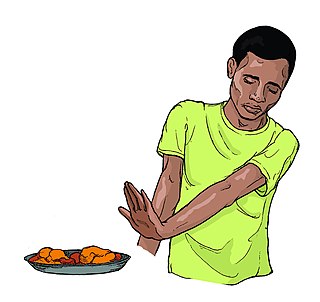Controversy and criticism
Many medical professionals and some anorexics view pro-ana as a glamorization of a serious illness. [52] Pro-ana began to attract attention from the mainstream press [4] when The Oprah Winfrey Show aired a special episode in October 2001 focusing on pro-ana. [53] Pressure from the public and pro-recovery organizations led to Yahoo and GeoCities shutting down pro-ana sites. [18] In response, many groups now take steps to conceal themselves, [36] disclaim their intentions as neutral and recovery-supportive (58% of sites in a 2006 survey), [12] or interview members to screen out the non-eating disordered. [54]
Medical profession
Health care professionals and medical associations have generally negative views of pro-ana groups and the information they disseminate: [55]
- The National Association of Anorexia Nervosa and Associated Disorders (ANAD) states that Pro-Ana sites "can pose a serious threat to some individuals, not simply because they promote eating disorder behaviors, but because they build a sense of community that is unhealthy. They lure the impressionable and persuade them that the Pro-Ana community is providing caring and nurturing advice." [56]
- The Academy for Eating Disorders (AED) stated that "websites that glorify anorexia as a lifestyle choice play directly to the psychology of its victims", expressing concern that sites dedicated to the promotion of anorexia as a desirable "lifestyle choice" "provide support and encouragement to engage in health threatening behaviors, and neglect the serious consequences of starvation." [57] However, one of its board members, Eric van Furth, has noted that pro-ana sites have relatively few visitors and advises against legal sanction of such sites, claiming instead that popular media play the more important role in establishing ideals of female thinness. [58]
- Bodywhys (the Eating Disorders Association of Ireland) notes that pro-ana sites "might initially help people to feel less isolated, but the community that they create is an unhealthy community that encourages obsessiveness and minimization of the seriousness of these potentially deadly disorders." [59]
- B-eat (the Eating Disorders Association of the UK) has remarked that those who seek out pro-ana sites do so "to find support, understanding and acceptance. We don't call for the sites to be banned, but rather for everyone else to consider how they can also provide that understanding and acceptance so that these sites don't become the only refuge for someone." [60]
- The UK Royal College of Psychiatrists has called for the Council of Child Internet Safety—a UK government advisory body—to expand its definition of harmful online content to include pro-ana sites, and to inform parents and teachers of the dangers of pro-ana, arguing that "the broader societal context in which pro-ana and pro-mia sites thrive is one where young women are constantly bombarded with toxic images of supposed female perfection that are impossible to achieve, make women feel bad about themselves and significantly increase their risk of eating disorders." [61] [62]
- The National Eating Disorders Association (NEDA) "actively speaks out against pro-anorexia and pro-bulimia websites. These sites provide no useful information on treatment but instead encourage and falsely support those who, sadly, are ill but do not seek help." [63] NEDA has also warned that journalists often glamorize anorexia by associating anorexia with personal self-control and that media coverage of pro-ana often triggers the already-anorexic by mentioning weights and calorie counts and by showing photographs of thin people. [64]
Media
In October 2001, The Oprah Winfrey Show hosted a special on anorexia; the pro-ana movement was discussed briefly by the guest panel, who expressed alarm at the appearance of pro-ana websites and recommended the use of filtering software to bar access to them. [53]
In July 2002, the Baltimore City Paper published an investigative report into pro-ana on the web. [65]
"Growing up Online", a January 2008 episode of the PBS Frontline television program, also featured a brief discussion of pro-ana. [66]
In April 2009, The Truth about Online Anorexia, an investigative documentary about pro-ana on the Internet, aired on ITV1 in the UK presented by BBC Radio 1 DJ Fearne Cotton.[ citation needed ]
In April 2012 speech at Harvard University, Vogue Italia editor Franca Sozzani conceded that the fashion industry may be a cause of the recent rise in eating disorders, but that the industry was being unfairly singled out for blame: "How can all this be possibly caused by fashion? And how come that Twiggy, who would be surely considered an anorexic today, did not arise controversy in the Sixties and did not produce a string of anorexia followers?" According to Sozzani, pro-ana sites were more effective at promoting eating disorders, and obesity was the more pressing public health problem that food industry was not being likewise attacked for exacerbating. [67]
The existence of pro-ana blogs and forums was featured in the 2014 Lifetime film Starving in Suburbia , which starred Polish actress Izabella Miko as "ButterflyAna", a beautiful model and moderator on the internet who promotes anorexia religiously to the followers of her blog. This entices teenager Hannah (Laura Wiggins) to become severely anorexic; this was also the first Lifetime film to address the subject matter of anorexia among men and boys, when Hannah's brother, Leo, is revealed to suffer from anorexia and later dies due to health complications from the disorder. [68] [69]
Arts

Thirty-two kilos, an exhibition by photographer Ivonne Thein, went on display at the Berlin Postfuhramt art exhibition center in May 2008 [70] and the Washington Goethe-Institut in January 2009, featuring photographs of young women digitally manipulated to appear skeletally thin. Thein said that the photographs were intended as a mocking and satirical take on pro-ana. However, many images from the exhibition were nevertheless later shared online as thinspiration. [71]
Social networking services
In July 2001, Yahoo—after receiving a letter of complaint from ANAD—began removing pro-ana sites from its Yahoo Clubs (now Yahoo Groups) service, stating that such sites endorsing self-harm were violations of its terms of service agreement. [72] [73]
LiveJournal has not made a position statement on pro-ana. In August 2007, however, a staff member declined to act on an abuse report filed against a pro-ana community hosted on its network, stating that:
Suspending pro-anorexia communities will not make anyone suffering from the disorder become healthy again. Allowing them to exist, however, has several benefits. It reassures those who join them that they are not alone in the way they feel about their bodies. It increases the chance that the friends and loved ones of the individuals in the community will discover their disorders and assist them in seeking professional help. [74]
Facebook staff seek out and regularly delete pro-ana related groups. A spokesperson for the online service has stated that such pages violate the site's terms of service agreement by promoting self-harm in others. [75]
MySpace does not ban pro-ana material and has stated that
"it's often very tricky to distinguish between support groups for users who are suffering from eating disorders and groups that might be termed as 'pro' anorexia or bulimia. Rather than censor these groups, we are working to create partnerships with organisations like b-eat."
MySpace has chosen instead to cycle banner advertisements for pro-recovery organizations through pro-ana members' profiles. [55]
In November 2007, Microsoft shut down four pro-ana sites on the Spanish-language version of its Spaces social networking service at the behest of IQUA, the Internet regulatory body for Catalonia. [76] A Microsoft spokesperson stated that such sites "infringe all the rules on content created by users and visible on our sites". [77]
In September 2008, San Sebastián-based Spanish-language web portal Hispavista removed its pro-ana forums at the request of the provincial prosecutor for Guipúzcoa and the Children's Ombudsman of Madrid, who stated that "while not illegal, the harmful and false information in such forums being disseminated to minors will impair their proper development." [78]
In February 2012, after consulting with NEDA, [79] the blog-hosting service Tumblr announced that it would shut down blogs hosted on its microblogging service which "actively promote or glorify self harm," including eating disorders, [80] and display warnings with names of organizations that can help facilitate recovery in people affected by eating disorders, on searches for common pro-eating disorder terms. [81] Despite this, Tumblr remains a large hub for pro-ana microblogging. [82] Pinterest, a social photo-sharing site, similarly amended its TOS [83] in March 2012 to ban pro-ana content, [79] but was similarly unsuccessful. [84] Instagram followed suit and announced in April 2012 that it would summarily disable any accounts on its photo-sharing service with pro-ana specific hashtags on images. [85]
TikTok's algorithm has been criticized for amplifying pro-ana content. [86]
Politics
In the United Kingdom, 40 MPs signed an early day motion tabled in February 2008 by the then Liberal Democrats member for Cheadle, Mark Hunter, urging government action against pro-ana sites. [87] The motion was timed to coincide with the UK National Eating Disorder Awareness Week. [88] [89]
In the United Kingdom, Jo Swinson, the Liberal Democrat member for East Dunbartonshire, called for advertisers to voluntarily adopt similar disclaimers in an adjournment debate in October 2009, and later in an early day motion tabled in February 2010. She has stated that such "photos can lead people to believe in realities that, very often, do not exist," and that "when teenagers and women look at these pictures in magazines, they end up feeling unhappy with themselves." [90]
In April 2008, a bill outlawing material which "provokes a person to seek excessive thinness by encouraging prolonged restriction of nourishment" was tabled in the French National Assembly by UMP MP Valérie Boyer. It imposes a fine of €30,000 and two years imprisonment (rising to €45,000 and three years if there was a resulting death) on offenders. [91] [92] [93] Health minister Roselyne Bachelot, arguing for the bill, stated that "giving young girls advice about how to lie to their doctors, telling them what kinds of food are easiest to vomit, encouraging them to torture themselves whenever they take any kind of food is not part of liberty of expression." [94] The bill passed the National Assembly, [95] but stalled in the Senate, where a June 2008 report by the Committee of Social Affairs emphatically recommended against such legislation and instead suggested early-screening programs by schools and physicians. [96]
Boyer subsequently introduced another bill in September 2009 to mandate disclaimers on photographs in which body parts have been retouched, with the aim of reducing the impact of unrealism in photography on young girls and women. [97] The bill was ostensibly targeted at advertising photography but could be broadly applicable to digitally manipulated photography in general, including thinspirational montages. It imposes a penalty of €37,500 per violation, with a possible rise to 50% of the cost of each advertisement. [98] The bill did not pass its first reading and was relegated to the Committee of Social Affairs. [99]
In April 2009, Dutch Minister for Youth and Family André Rouvoet called for click-through warnings to be added to all pro-ana sites on Dutch hosting services, citing a successful trial of such warnings by blog host punt.nl in 2006. The Dutch Hosting Provider Association, however, has stated that "the Internet is simply a reflection of a world with many undesirable things", and that its members cannot be held responsible for monitoring and disclaiming all hosted content. [100]
In March 2012, the Israeli Knesset passed a bill sponsored by Kadima MK Rachel Adato and Likud MK Danny Danon requiring advertisements which have been retouched to alter the body shape of models to fully disclose the fact. The bill, which applies to both foreign-produced and locally produced advertising, also sets a lower BMI limit for models featured in advertisements of 18.5 (the threshold of underweight under World Health Organization guidelines). [101] [102] [103]
Popular culture
In a November 2009 interview with Women's Wear Daily , model Kate Moss gave a popular thinspirational slogan as her motto: "Nothing tastes as good as skinny feels." [104] Moss came under widespread criticism—particularly by eating disorder recovery organizations—for endorsing pro-ana. Her agency, Storm, stated: "This was part of a longer answer Kate gave during a wider ranging interview which has unfortunately been taken out of context and misrepresented." [105] Still, Moss has been known in the fashion world to have helped popularize the "heroin chic" trend, which uses models with disheveled, ultra-skinny, and waif-like body types on the runway. [106]





